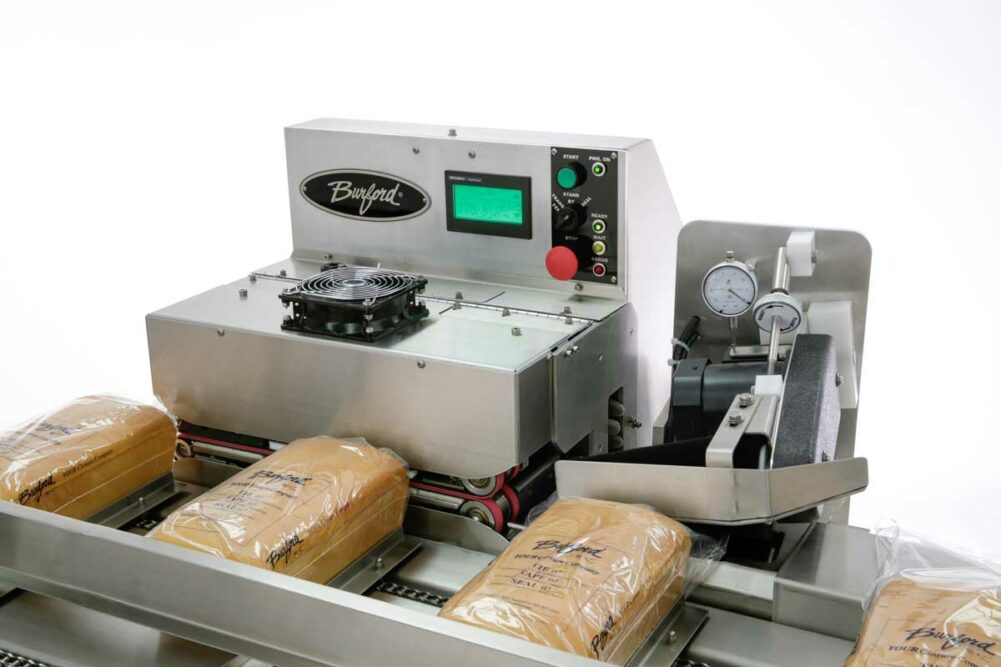Bread doesn’t typically have tamper-evident packaging; that’s usually reserved for snacks. But bakers wanting to use tamper-evident packaging have a few options for any type of baked food.
For individual products, label application can provide consumers with a visual indicator that the package has remained sealed. EPI, a brand of ProMach, offers the EPI 9220 or 9230 Labeling Systems that dispense the label to the top, front and bottom of clamshell containers to meet changing packaging needs for tamper evidence.
“Label application has evolved from a small two-side top-leading, face-applied label to a three-side-applied label, or C-wrap label,” said Jim Immel, EPI regional sales manager, ProMach.
The EPI 9220 reduces production cost by automating the labeling process.
With its TEC200, Burford introduced a non-contact sealing method. Rather than a hot roller pressing the bag together, the machine blows hot air on the top and bottom, fusing the bag together. A crimper then adds a design to the seal to make it more apparent to the consumer.
“To make the package easy to open, we can also perforate the bag tail so the consumer can easily zip it off,” said Mitch Lindsey, senior sales account manager, Burford Corp., a Middleby Bakery company.
This is a common change with tamper-evident packaging that may have kept the baking industry from fully embracing it. While this kind of packaging proves to the consumer that no one has contaminated their food, the packaging doesn’t always remain intact after it’s opened.
“It has a perforated seam on it so you can easily remove it instead of tearing the whole bag apart trying to get in it like you do on a bag of carrots that has that seal that you can never get off,” he went on to explain.
Similarly, Kwik Lok’s laser-stitched tamper evident system, the 909A uses laser technology rather than heat sealing to stitch the bag closed, creating a visual cue that the bag hasn’t been opened. It readily releases to open without destroying it, as in the case of heat-sealing systems.
“With heat sealing, as soon as the bag is opened, it’s destroyed,” explained Ron Cardey, senior vice president, customer engagement, Kwik Lok. “This takes away from the reusability and increases food waste, and the consumer has to come up with a different container to preserve the food.”
The 909A also only takes up 10 inches of space as compared with the 3 feet a heat-sealing unit can require in floorspace, a limited commodity in crowded packaging departments.
“It doesn’t negatively impact any line we’ve put it on so far,” Mr. Cardey said. “Every bakery I’ve been in can find 10 inches of space.”
As with all bakery equipment, operators look for machines that are simplified and easy to changeover. As packaging suppliers innovate in the realm of tamper evidence, basic ease of operation cannot be ignored.
“Bakers need the tamper-evident packaging equipment to be simple to operate, and the packaging needs to be obvious to the consumer that it has or hasn’t been tampered with and have good integrity,” said Dennis Gunnell, president, Formost Fuji. “The equipment has become streamlined and more simplified. The tamper-evident units are becoming more refined, which makes them easier to operate.”
Formost Fuji’s Alpha 8 horizontal form/fill/seal machine, for example, features an advanced design for mechanical simplicity that provides a quality seal. The end-seal system is more accessible, making it easier to do changeovers, and the wrapper features a shorter film route that reduces film waste. It wraps bread before bagging it, giving bakers both resealability on the bag but also tamper-evidence with the wrap.





